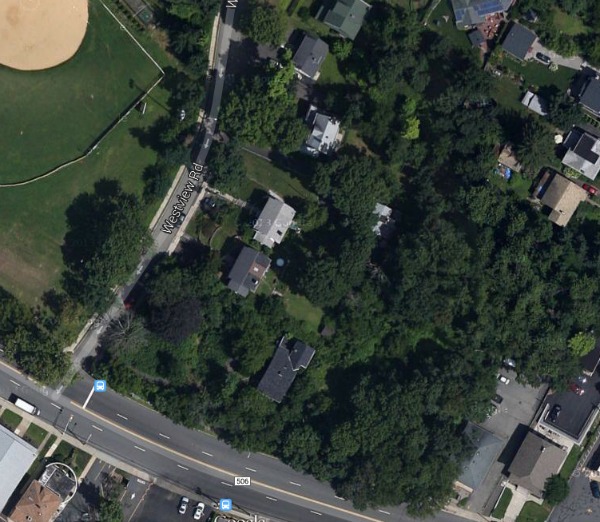
The proposed development of two steep, wooded lots on Bloomfield Avenue is headed into a third year of testimony and deliberation after experts differed sharply on Thursday night over how the site would fare in a storm.
J. Michael Petry, the planner for DMH2, presented a revised stormwater management report for 176-200 Bloomfield Avenue, the two lots that developer DMH2 is looking to turn into ground-floor commercial space and apartments, with parking lots in front and behind. To do that, DMH2 intends to cut down all of the trees now on the property and remove the all of the soil and bedrock on the site. A stormwater management report was needed to show how rainwater and melted snow would run off the site in the future.
On a lot as covered with trees as these two lots are now, rain and melting snow filters slowly through the ground, adding to the groundwater before it makes its way to rivers and streams. When a site is built on or paved over, precipitation can’t soak into the ground. It flows into storm drains and sewer systems at a rapid pace (watch how water runs from your driveway into the street when it pours this weekend), which can cause them to back up or overflow. Because of the importance of natural filtering, there are state laws against interfering with it.
Jessica Pearson, a Montclair Avenue resident who has been opposed to the development, asked for DMH2 to revise its first stormwater management plan because it described the site as one acre of open space and a half acre of woodlands. Everett Field, shown in the upper left corner of the photo above, meets the New Jersey Department of Environmental Protection’s definition of an open space. The two DMH2 lots are covered with trees and brush. While some of the calculations changed in the new report because the building is now slightly smaller, it continued to present the site as one acre of open space and a half acre of woodlands.
John A. Miller, a certified stormwater manager, challenged the DMH2 report, saying that it shows higher runoff than actually exists now, which alters the comparison with the site after development. Miller, who works for the environmental engineering firm Princeton Hydro, was retained by Pearson and her husband, Jack McEvoy. He testified that DMH2 “completely failed” to meet both Verona’s stormwater management rules and those of the state. Miller said that DMH2’s design was “clearly in violation” of a Verona law that requires a 15-foot natural buffer to be kept between a development and residential areas, and that, while DMH2’s proposed stormwater system was designed for a so-called 25-year event, Verona has had four storms stronger than that in the last four years alone. Miller was also concerned that, because the project’s driveway would send runoff straight down into Bloomfield Avenue, it could cause an ice hazard on the road in winter. (You can read Miller’s letter to the Planning Board here.)
Because the two views of the stormwater management plan were so different, Planning Board Chairman William Brown asked Verona Township Engineer Jim Helb to report on the two presentations at the next meeting. Helb, who has been very deferential to DMH2’s witnesses since the developer came before the Planning Board last August, challenged Miller’s views at several points on Thursday. Helb functions as both an advisor to the Board and a voting member, something that Miller noted is generally frowned upon elsewhere.
In other action, the Planning Board directed Jason Kasler, a planner who advises Verona, to conduct a study as to whether the former Annin flag factory and surrounding properties are a so-called area in need of redevelopment. If Kasler finds that it is, it opens the way for a redevelopment of the factory as apartments that pay a payment-in-lieu-of-taxes (PILOT), instead of property taxes. In a PILOT, 95% of the tax revenue goes to the town government, 5% to the county and none for schools. The Board of Education gets 55% of regular property taxes. Kasler was not given a deadline for his report.
The Planning Board’s next meeting is Thursday, June 26. DMH2 first presented its project to the Verona Board of Adjustment on June 12, 2012.

